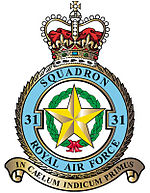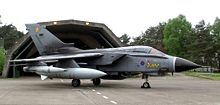- No. 31 Squadron RAF
-
No. 31 Squadron RAF 
Active 11 October 1915 Role Air Interdiction, Ground Attack, Close Air Support, Reconnaissance, Suppression of enemy Air Defenses Garrison/HQ RAF Marham Motto In cælum indicum primus
Latin:"First into Indian skies"Equipment Tornado GR4 Battle honours North West Frontier 1916–1918, Afghanistan 1919–1920, Mahoud 1919–1920, Waziristan 1919–1925, North West Frontier 1939, Iraq 1941, Syria 1941, Egypt and Libya 1941–1942, Burma 1941–1942, North Burma 1943–1944, Arakan 1943–1944, Manipur 1944, Burma 1944–1945, Gulf 1991, Kosovo, Iraq 2003 Insignia Identification
symbolA mullet (star) in front of a wreath of laurel. No. 31 Squadron of the Royal Air Force, known as the 'Goldstars',[1] currently operates the Tornado GR4 from RAF Marham, Norfolk.
Contents
History
The squadron was formed at Farnborough on October 11, 1915. Its first deployment was to Risulpur, India with its BE2Cs and Farmans, and during this time it took part in operations in the Third Anglo-Afghan War and on the North-West Frontier. In September 1919 BE2s were replaced by Bristol Fighters.
In April 1939 the Squadron changed to the bomber transport role. During 1941, the Squadron began to concentrate on transport duties with seconded DC-2s. Returning to India the squadron re-equipped with the Dakota. After the Japanese invasion of Burma, it flew missions between Calcutta and Rangoon dropping supplies for the XIVth Army. After World War II the squadron moved to Java. In 1946 the Squadron was disbanded in Java and reformed at Mauripur, India.
At the end of 1947 it was again disbanded, but reformed in July 1948. In 1955, the unit reverted to its previous identity, and No. 31 Squadron moved to Laarbruch in Germany with Canberra PR7s. The squadron flew Canberras until 1971 when they were replaced by Phantoms.
The Phantoms were replaced in 1976 when the squadron re-equipped with twelve Jaguar strike aircraft, and assigned to SACEUR, were declared operational at RAF Bruggen with conventional weapons and eight British WE.177 nuclear bombs from 1977[2] to 1984.[3] where their role was in support of land forces in a high-intensity European war using conventional weapons initially, and tactical nuclear weapons if a conflict escalated.
The squadron took delivery of Tornado GR1s in 1984. The squadron's assignment to SACEUR and its war role did not change, although the squadron's allocation of WE.177 weapons increased to eighteen to account for the greater capacity of the Tornado, which could each carry two nuclear weapons, and the ratio of weapons to aircraft at full strength increased to 1.5 : 1.[4] The apparent mismatch between aircraft numbers and WE.177 numbers is explained thus: RAF staff planners expected up to one third attrition in a conventional European high-intensity war, and some aircraft were to be held back in reserve to ensure that if a conflict escalated to use of tactical nuclear weapons, there were sufficient aircraft surviving to deliver the squadron's full stockpile of eighteen nuclear weapons.[5] The squadron's nuclear strike role continued at RAF Bruggen until 1994.[6] and ended with retirement of the WE.177 weapon in the period 1994–98.
In 1991, No 31 Sqn was the lead Squadron of the Dhahran Tornado GR1/GR1A detachment during Op Granby (Gulf War 1). Under the overall command of Wing Commander Jeremy (Jerry) Witts, the composite squadron was principally comprised from 31 Sqn with elements of Nos IX, 14 amd 17 Sqns together with a reconnaissance flight formed from elements of Nos II (AC) and 13 Sqns. Aircrew from Nos 12 and 617 Sqns were also attached. Wg Cdr Witts was subsequently awarded the Distinguished Service Order (DSO) for his actions.
31 Sqn was the last RAF Squadron to be based at RAF Bruggen in Germany, before returning to the UK to be based at RAF Marham in August 2001.
In 2003, within Operation Telic, during the Iraq War, No. 31 Squadron was the lead Squadron that formed the Ali Al Salem Combat Air Wing in Kuwait; an amalgamated Composite squadron of 31, 9, 617 and II Squadron crews under the overall command of Wing Commander Paddy Teakle (OC 31 Squadron at the time). His actions in command of the Squadron earned him the DSO.
Current role
Now part of the Marham Wing, 31 Squadron's aircraft and crews were part of the RAF Tornado force in the 1991 Gulf War and the Squadron has continued to fly on regular operations over Iraq. On Jan 1, 1995 the Squadron was declared operational in the Suppression of Enemy Air Defences (SEAD) role equipped with the Air Launched Anti Radiation Missile ALARM Anti Radiation Missile. During 1999 the Squadron re-equipped with the Tornado GR4 . 1999 also saw 31 Sqn participate in Operation Engadine, NATO operations over the Federal Republic of Yugoslavia. For the latter part of this operation the Squadron was temporarily based in Corsica.
In 2001 No 31 Squadron moved to RAF Marham, and in 2003 formed the core of the Ali Al Salem Air Combat Wing, operating over Iraq during Operation Resinate South and Operation Telic.
While all Tornado GR.4s are capable of carrying the ALARM Anti Radiation Missile, only 31 and IX Sqns specialise in the role. In this role they are known as "Pathfinder" squadrons.
31 Squadron became the lead RAF Tornado GR4 unit on the Brimstone anti-tank missile, accepting the weapon into RAF service at its home base, RAF Marham, on April 7, 2005.
The Squadron has recently completed a 3 month tour of Afghanistan on Operation Herrick providing fast air support to ground troops in contact. They achieved a 100% sortie success rate, the first Tornado squadron to achieve this milestone on an operational detachment. They recently received their Operation Herrick service medals from the Air Officer Commanding 1 group Air Vice-Marshal G J Bagwell CBE.
Notable members
- Bomber Harris was a former Goldstar.
- John Peters of Gulf War 1 fame was a former Goldstar.
See also
- List of RAF squadrons
External Links
References
- ^ Portail d'informations Ce site est en vente!
- ^ RAF nuclear front line Order-of-Battle 1977-78
- ^ RAF nuclear front line Order-of-Battle 1984
- ^ RAF nuclear front line Order-of-Battle 1985
- ^ Weapon overview @ www.nuclear-weapons.info/vw.htm#WE.177 Carriage
- ^ RAF nuclear front line Order-of-Battle 1994
GR1 GR4 No. 9 Squadron · No. 12 Squadron · No. 14 Squadron · No. 15 (Reserve) Squadron · No. 31 Squadron · No. 617 SquadronGR4A F3 Currently active Inactive 1 · 4 · 10 · 13 · 20 · 21 · 23 · 25 · 26 · 34 · 35 · 36 · 37 · 38 · 40 · 42 · 43 · 44 · 46 · 48 · 49 · 50 · 52 · 53 · 55 · 58 · 59 · 61 · 62 · 63 · 64 · 65 · 66 · 67 · 68 · 69 · 70 · 71 · 73 · 74 · 75 · 76 · 77 · 79 · 80 · 81 · 82 · 83 · 85 · 86 · 87 · 88 · 89 · 90 · 91 · 92 · 93 · 94 · 95 · 96 · 97 · 98 · 102 · 103 · 104 · 105 · 106 · 107 · 108 · 109 · 110 · 111 · 112 · 113 · 114 · 115 · 116 · 117 · 118 · 119 · 120 · 121 · 122 · 123 · 124 · 125 · 126 · 127 · 128 · 129 · 130 · 131 · 132 · 133 · 134 · 135 · 136 · 137 · 138 · 139 · 140 · 141 · 142 · 143 · 144 · 145 · 146 · 147 · 148 · 149 · 150 · 151 · 152 · 153 · 154 · 155 · 156 · 157 · 158 · 159 · 160 · 161 · 162 · 163 · 164 · 165 · 166 · 167 · 168 · 169 · 170 · 171 · 172 · 173 · 174 · 175 · 176 · 177 · 178 · 179 · 180 · 181 · 182 · 183 · 184 · 185 · 186 · 187 · 188 · 189 · 190 · 191 · 192 · 193 · 194 · 195 · 196 · 197 · 198 · 199 · 200 · 201 · 204 · 205 · 209 · 210 · 211 · 212 · 213 · 214 · 215 · 217 · 218 · 219 · 220 · 221 · 222 · 223 · 224 · 225 · 226 · 227 · 228 · 229 · 231 · 232 · 233 · 234 · 235 · 236 · 237 · 238 · 239 · 240 · 241 · 242 · 243 · 244 · 245 · 246 · 247 · 248 · 249 · 250 · 251 · 252 · 253 · 254 · 255 · 256 · 257 · 258 · 259 · 260 · 261 · 262 · 263 · 264 · 265 · 266 · 267 · 268 · 269 · 270 · 271 · 272 · 273 · 274 · 275 · 276 · 277 · 278 · 279 · 280 · 281 · 282 · 283 · 284 · 285 · 286 · 287 · 288 · 289 · 290 · 291 · 292 · 293 · 294 · 295 · 296 · 297 · 298 · 299 · 353 · 354 · 355 · 356 · 357 · 358 · 360 · 361 · 510 · 511 · 512 · 513 · 514 · 515 · 516 · 517 · 518 · 519 · 520 · 521 · 524 · 525 · 526 · 527 · 528 · 529 · 530 · 531 · 532 · 533 · 534 · 535 · 536 · 537 · 538 · 539 · 540 · 541 · 542 · 543 · 544 · 547 · 548 · 549 · 550 · 567 · 569 · 570 · 571 · 575 · 576 · 577 · 578 · 582 · 586 · 587 · 595 · 597 · 598 · 618 · 619 · 620 · 621 · 622 · 623 · 624 · 625 · 626 · 627 · 628 · 629 · 630 · 631 · 635 · 639 · 640 · 644 · 650 · 651 · 652 · 653 · 654 · 655 · 656 · 657 · 658 · 659 · 660 · 661 · 662 · 663 · 664 · 665 · 666 · 667 · 668 · 669 · 670 · 671 · 672 · 673 · 679 · 680 · 681 · 682 · 683 · 684 · 691 · 692 · 695
Australian Flying Corps (AFC) units attached
to the RAF during the First World WarCommonwealth air force units attached to
the RAF during the Second World War.Squadrons formed from non-Commonwealth
personnel during the Second World WarArgentineBelgian349 · 350CzechoslovakDutchFrenchGreek335 · 336NorwegianYugoslavRoyal Auxiliary Air Force Special ReserveAuxiliary Air ForceFleet Air Arm of the RAF (1924–1939) Categories:- Royal Air Force aircraft squadrons
- RAF Marham units
- Military units and formations established in 1915
- Royal Flying Corps squadrons
- 1915 establishments in the United Kingdom
Wikimedia Foundation. 2010.

